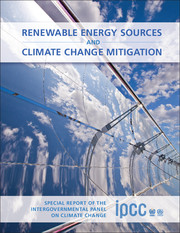 Renewable Energy Sources and Climate Change Mitigation
Renewable Energy Sources and Climate Change Mitigation Published online by Cambridge University Press: 05 December 2011
Executive Summary
Historically, economic development has been strongly correlated with increasing energy use and growth of greenhouse gas (GHG) emissions. Renewable energy (RE) can help decouple that correlation, contributing to sustainable development (SD). In addition, RE offers the opportunity to improve access to modern energy services for the poorest members of society, which is crucial for the achievement of any single of the eight Millennium Development Goals.
Theoretical concepts of SD can provide useful frameworks to assess the interactions between SD and RE. SD addresses concerns about relationships between human society and nature. Traditionally, SD has been framed in the three-pillar model—Economy, Ecology, and Society—allowing a schematic categorization of development goals, with the three pillars being interdependent and mutually reinforcing. Within another conceptual framework, SD can be oriented along a continuum between the two paradigms of weak sustainability and strong sustainability. The two paradigms differ in assumptions about the substitutability of natural and human-made capital. RE can contribute to the development goals of the three-pillar model and can be assessed in terms of both weak and strong SD, since RE utilization is defined as sustaining natural capital as long as its resource use does not reduce the potential for future harvest.
To save this book to your Kindle, first ensure no-reply@cambridge.org is added to your Approved Personal Document E-mail List under your Personal Document Settings on the Manage Your Content and Devices page of your Amazon account. Then enter the ‘name’ part of your Kindle email address below. Find out more about saving to your Kindle.
Note you can select to save to either the @free.kindle.com or @kindle.com variations. ‘@free.kindle.com’ emails are free but can only be saved to your device when it is connected to wi-fi. ‘@kindle.com’ emails can be delivered even when you are not connected to wi-fi, but note that service fees apply.
Find out more about the Kindle Personal Document Service.
To save content items to your account, please confirm that you agree to abide by our usage policies. If this is the first time you use this feature, you will be asked to authorise Cambridge Core to connect with your account. Find out more about saving content to Dropbox.
To save content items to your account, please confirm that you agree to abide by our usage policies. If this is the first time you use this feature, you will be asked to authorise Cambridge Core to connect with your account. Find out more about saving content to Google Drive.